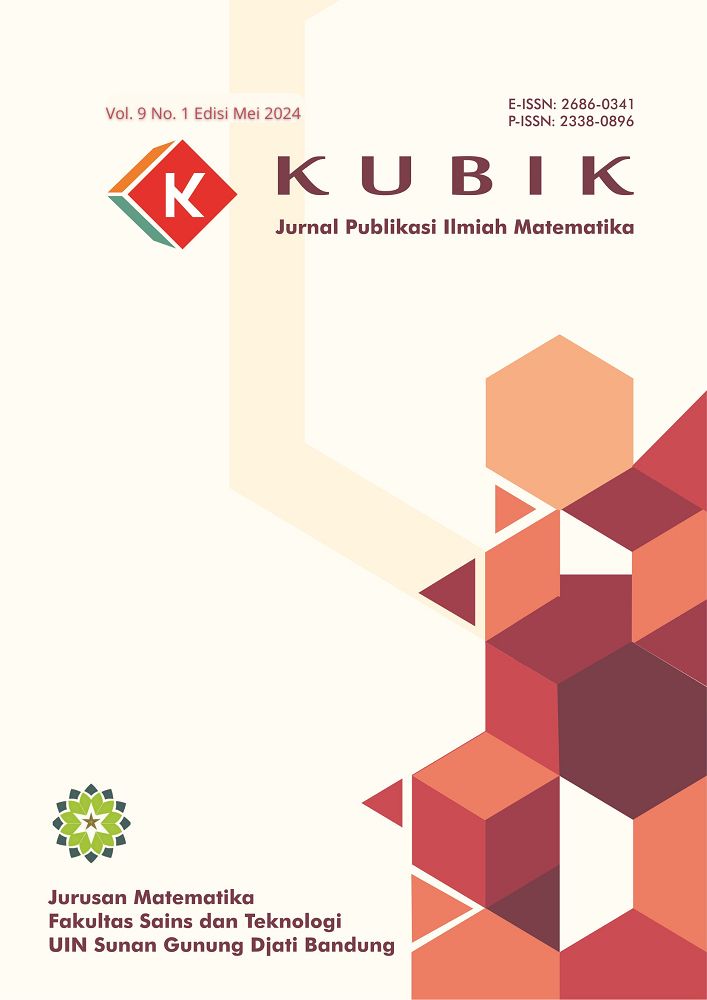Comparative Study of Parameter Estimation Methods in Pharmacokinetic Model with Oral Administration: Simulations of Theophylline Drug Concentration
DOI:
https://doi.org/10.15575/kubik.v9i1.31233Keywords:
Pharmacokinetic Model, Parameter Estimation, Wagner-Nelson, ResidualAbstract
References
N. S. Al-Mumtazah, Widodo, and Indarsih, "Drug elimination in two-compartment phar macokinetic model with nonstandard finite difference approach," Int. J. Appl. Math. vol. 50, 2020.
C. N. Angstmann, B. I. Henry, B. A. Jacobs, and A. V. McGann, "An explicit numerical scheme for solving fractional order compartment models from the master equations of a stochastic process," Commun. Nonlinear Sci. Numer. Simul. vol. 68, pp. 188–202, 2019.
C. N. Angstmann et al., "Fractional order compartment models," SIAM J. Appl. Math. vol. 77, pp. 430–446, 2017.
W. E. Boyce, and R. C. DiPrima, "Elementary Differential Equations and Boundary Value Problems," John Wiley & Sons, 2012.
O. Egbelowo, “Nonlinear elimination of drug in one-compartment pharmacokinetic models: Nonstandard finite difference approach for various routes of administration,†Math. Comput. Appl., vol.23 (2018).
O. Egbelowo, C. Harley, and B. Jacobs, “Nonstandard finite difference method applied to a linear pharmacokinetics model,†Bioeng., vol. 4, 2017.
A. T. Florence, and E. G. Salole, “Routes of Drug Administration,†Wright, 1980.
M. Gibaldi, and D. Perrier, “Pharmacokinetics†Informa, 2007.
F. R. Giordano, W. P. Fox, and S. B. Horton, “A First Course in Mathematical Modeling,†Brooks/Cole, 2014.
M. A. Hedaya, “Basic Pharmacokinetics,†CRC Press, 2012.
M. Khanday, A. Rafiq, and K. Nazir, “Mathematical models for drug diffusion through the compartments of blood and tissue medium,†Alexandria J. Med., vol. 53, pp. 245–249, 2017.
J. Kim, and O. De Jesus, “Medication Routes of Administration,†StatPearls Publishing, 2024.
E. Kreyszig, “Advanced Engineering Mathematics,†John Wiley & Sons, 2011.
S. Mtshali, and B. A. Jacobs, “On the validation of a fractional order model for pharmacokinetics using clinical data,†Fractal Frac., vol 7, no. 84, 2023.
V. S. R. K. Reddy, and K. L. Narayah, “The concentration of digoxin after intravenous and oral administration studied by a two-compartment model,†Lett. Biomath., vol. 6, 2019.
W. A. Ritschel, “Handbook of Pharmacokinetics,†Drug Intelligence Publication, 1976.
M. A. Rodrigo, “Laplace transform approach to direct and inverse problems for multicompartment models,†Eur. J. Appl. Math., vol. 33, pp. 1–15, 2022.
M. Savva, “A Mathematical treatment of multiple intermittent intravenous infusion in a one-Compartment Model,†Comput. Methods and Programs in Biomed., vol. 205, 2021.
M. Savva, “Real-time analytical solutions as series formulas and heaviside off/on switch functions for multiple intermittent intravenous oinfusions in One and two-compartment models,†J. Biosci. Med., vol. 10, 2022.
L. Shargel, and A. B. C. Yu, “Applied Biopharmaceutics and Pharmacokinetics,†McGraw-Hill, 2005.
P. Sopasakis, H. Sarimveis, P. Macheras, and A. Dokoumetzidis, “Fractional calculus in pharmacokinetics,†J. Pharmacokinet. Pharmacodyn., vol. 45, pp. 107–125, 2018.
J. G. Wagner, and E. Nelson, “Percent absorbed time plots derived from blood level and/or urinary excretion data,†J. Pharm. Sci., vol. 52, pp. 610–611, 1963.
J. G. Wagner, “Pharmacokinetics for the Pharmaceutical Scientist,†CRC Press, 2019.
D. Zulkarnaen, M. S. Irfani, and E. S. Erianto, “Drug-drug interactions pharmacokinetic models with extravascular administration: estimation of elimination and absorption rate constants,†Jur. Teori Apl. Mat., vol. 7, pp. 1077–1093, 2023.
Downloads
Published
How to Cite
Issue
Section
Citation Check
License
Authors who publish in KUBIK: Jurnal Publikasi Ilmiah Matematika agree to the following terms:
- Authors retain copyright and grant the journal right of first publication with the work simultaneously licensed under a Attribution-ShareAlike 4.0 International (CC BY-SA 4.0) License that allows others to share the work with an acknowledgment of the work's authorship and initial publication in this journal.
- Authors are able to enter into separate, additional contractual arrangements for the non-exclusive distribution of the journal's published version of the work (e.g., post it to an institutional repository or publish it in a book), with an acknowledgment of its initial publication in this journal.
- Authors are permitted and encouraged to post their work online (e.g., in institutional repositories or on their website) prior to and during the submission process, as it can lead to productive exchanges, as well as earlier and greater citation of published work (See The Effect of Open Access).
Â









